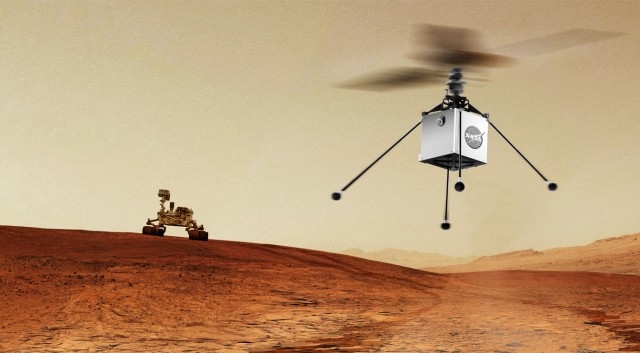On May 5, NASA launched its InSight lander which is estimated to land on the Martian surface later this year. The space agency has launched a number of rovers, orbiters, and landers to the red planet with Curiosity being the latest in operation. But, according to the reports that surfaced recently, NASA is ready to launch its next rover to the Mars in 2020. But that’s not all. The upcoming rover will look for past life on the red planet including microbial life and it will conduct series of experiments using its sophisticated instruments. What’s more exciting is that NASA has actually approved a drone-like helicopter that will be mounted with the rover and it will be launched during 2020 Mars mission.
This is the first time that a helicopter has been designed and will be launched to the red planet to fly in the Martian atmosphere. According to the reports, the upcoming helicopter would allow the scientists to have a bird’s view of the Martian surface which will provide a totally new perspective in the future. As per the design which has been undergoing for the last four years, the Mars helicopter will weigh around four pounds i.e. 1.8 kilograms and the dimensions will be similar to a softball.
Martian atmosphere is different from the Earth’s because it is very thin. To put things into perspective, the surface atmosphere on the red planet is equivalent to the altitude of 100,000 feet on the Earth which will pose a significant difficulty in flying. As per the details available, the helicopter will have counter-rotating blades which will spin more than 3,000 rotation per minute (rpm). The helicopter will be powered by lithium-ion batteries and solar cells will be mounted to charge the batteries when needed. According to Thomas Zurbuchen, the associate administrator for NASA’ Science Mission Directorate, the upcoming 2020 Mars mission will be a perfect opportunity to test the helicopter on the red planet.
The space agency will conduct a 30-day flight test campaign where it would test the helicopter to fly at an altitude of 10 feet, hover for 30 seconds during the initial tests and then, gradually increasing the variables to get the required results. NASA quoted that more than 117 years ago, Wright brothers proved that a controlled, sustained, and powered flight can be achieved on Earth. Thus, it is the chance for another team of researchers to prove the same on a different planet.
Talking about the upcoming Mars rover (2020), it will launch in 2020 and it is estimated to land in February 2021. The mission will concentrate mainly on past life while using its state-of-the-art and sophisticated instruments which include Moxie – to test production of oxygen from CO2; MastCam-Z – zoomable panoramic camera; Sherloc – an UV spectrometer to study chemistry and mineralogy; Rimfax – penetrative radar to explore surface; MEDA – rover’s weather station; PIXL – an X-ray spectrometer to probe chemical composition of soil and other instruments. The rover will also store samples from the Martian surface in small tubes that would be retrieved for testing on Earth in the future.
